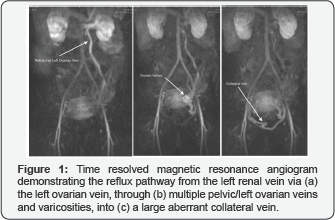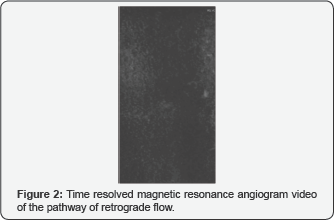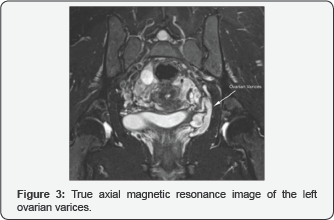Juniper Publishers: Not So Good Vibrations: Vascular Reflux and the Sensation of Retropubic Vibration following Nova sure Endometrial Ablation
JUNIPER PUBLISHERS- JOURNAL OF GYNECOLOGY AND WOMEN’S
HEALTH
Journal of Gynecology and Women’s Health-Juniper
Publishers
Authored by Romy Nitsch*
Abstract
Background: One in five women suffer
from abnormal uterine bleeding and endometrial ablation often
successfully treats refractory abnormal uterine bleeding. The
second-generation Nova Sure endometrial ablation system is effective and
safe. We report a case of vascular reflux from ovarian vessels creating
a retropubic vibration after Nova Sure endometrial ablation.
Case: A 48-year-old woman with an
endometrial ablation six months previously presented with a confusing
complaint of retropubic vibration that had been dismissed by several
physicians as impossible to explain. Investigation revealed left ovarian
varicosities and an aberrant vessel behind the pubic symphysis that
coursed from the left uterine venous sinus into the right internal iliac
vein.
Conclusion: This case report
presents an unusual postoperative complication of endometrial ablation
and reinforces the need to carefully evaluate patient complaints even
when they may seem contrived.
Keywords: Endometrial ablation; Nova sure; Vascular reflux; Ovarian varicosities; Aberrant vesselAbbreviations: AUB: Abnormal Uterine Bleeding
Introduction
One in five women suffer from abnormal uterine bleeding (AUB) [1]. Endometrial ablation is minimally invasive surgery designed to treat AUB refractory to medical management [2-5].
Endometrial ablation destroys or removes the endometrial lining of the
uterus with the aim to decrease or eliminate menorrhagia, and increase
quality of life in women who do not desire to be fertile in the future [2].
In the past 20 years, non-resectoscopic second-generation endometrial
ablation techniques have been developed to shorten operative time,
minimize complications and reduce the amount of operative equipment
required [6,7].
The NovaSure endometrial ablation system is a
non-resectoscopic second-generation single-use device which utilizes
bipolar radiofrequency energy [2]. Its application is a well-established safe procedure with only rare serious complications [2,8].
Cardiovascular complications noted in the literature include
hypotension, chest pain, deep vein thrombosis, CO2 embolism,
bradycardia, pulmonary embolism, and cardiac arrest [7,9].
We describe an unusual case of vascular malformation specifically
venous reflux following Nova Sure endometrial ablation which has to date
not been noted (Figure 1).

The Case
A 48-year-old multiparous woman
presents with a five-year history of uterine bleeding. After no
improvement of menorrhagia was found with medical therapies including
oral tranexamic acid (Cyklokapron®), and the Mirena IUS failed to
control bleeding, a decision was made to proceed to endometrial
ablation. A week prior to the ablation on examination, normal vulva,
vagina and cervix were visualized, a PAP smear was performed and a
bimanual exam revealed a non-tender abdomen with a small anteverted
uterus. There was no mass palpated (Figure 2).

Under general anesthesia, dilation and curettage was
performed. No hyperplasia or malignancy was found. Nova Sure endometrial
ablation was then performed as per protocol. The patient’s endometrial
cavity seemed normal. No intra-operative complications were noted and
the patient tolerated the procedure well.
After the ablation the patient’s bleeding subsided.
Six months after the procedure the patient became aware of a constant
vibrating sensation in the retropubic and pelvic region extending down
into the vaginal region. The sensation could not be palpated. The
patient denied the typical pelvic congestion syndrome symptoms, however
the patient did describe aheaviness in the pelvis following exercise and
later in the day which resolved in the recumbent position. Apart from
the vibration sensation the patient had no other complaints.

She was evaluated by her family physician and by two
different gynecologists. None of these physicians could detect a
vibration nor could they explain the cause of the symptom. Considering
that an arterio-venous fistula is often associated with vibration one of
the physicians recommended a pelvic MRI (Figure 3).
Thirteen months post procedure she was evaluated by
diagnostic radiology. Multi planar and multi sequence images including a
time resolved MR angiogram of the abdomen and pelvis showed left
ovarian varicosities and dramatic reflux from the left renal vein into
multiple pelvic/left ovarian veins all emptying into a large venous
sinus at the border of the uterus. The venous sinus appeared to drain
through a 6 mm aberrant retropubic vein across to the opposite side of
the pelvis and into the right internal iliac venous system, running in
parallel and close contact with the pubic rami. No definite venous
outflow via the left internal iliac system was seen (Figure 4).

Discussion
We performed searches of the electronic database
PubMed and the Manufacturer and User Facility Device Experience (MAUDE)
database of the American Food and Drug Administration for reports of
similar squeal of endometrial ablation and concluded that this is the
first report of both ovarian reflux and the subjective sensation of
vibration following Nova Sure endometrial ablation.
Ovarian reflux is retrograde flow in the ovarian
vein(s) thought to be caused by venous incompetence. In time, it is
believed that this retrograde flow then incites the development of
varicosities and dilation of ovarian, paraovarian and pelvic veins [10].
The physical symptom of vibration has long been
associated with vascular malformations and so the sensory symptom of
pelvic vibration occurring in concert with a pelvic vascular
malformation may thus be explained [11].
The second-generation NovaSure endometrial ablation system uses thermal energy to vaporize the endometrial wall [12].
Under local or general anesthesia, the NovaSure travels the
endocervical canal, suctions the endometrium to its triangular
conformable mesh head and treats the tissue with a uterine-size
appropriated voltage until the tissue impedance increases rapidly
indicating the myometrial layer is reached or a maximum time of 120
seconds has elapsed [4,13]. As performed without direct visual guidance, the greatest concern of this procedure is off target thermal injury [12].
The NovaSure system assesses cavity integrity
pretreatment by CO2 pressurization to avoid direct off target thermal
injury however indirect off target thermal injury may be occurring [4].
Ovarian vein reflux has been reported secondary to a
previous pelvic surgery and can arise secondary to a more central flow
obstruction [14].
Though its pathology is unknown, it is thought to result from a
combination of dysfunctional venous valves, retrograde blood flow and
venous engorgement [15].
Venous valves may be physiologically absent in the cranial portion of
the ovarian vein in up to 15% of women on the left side and in up to 6%
on the right side, and valvular incompetence may be found on at least
one side in almost 50% of women [16].
The ovarian veins arise from the ovarian vein plexus which has venous communication with the uterine plexus [17].
Thermal propagation or mechanical damage causing reflux and engorgement
could thus originate in the uterine or ovarian vein plexus or impact
the ovarian vein or one of its draining vessels.
The injury in this case likely affected a greater
draining vessel as no definite venous outflow via the left internal
iliac system was seen. Reflux from the left renal vein drained into
multiple left ovarian veins and pelvic veins. All venous out flow
appeared to eventually flow through an enlarged congenitally aberrant
retropubic vein to the right iliac venous system.
The retropubic path of this aberrant vein parallel
to, and in close contact with, the pubic rami, and its size of 6mm may
explain the patient’s vivid pelvic vibration. The patient’s history,
examination and other investigations offered no alternate explanation
therefore vascular embolization of the enlarged vein and the left
ovarian vein was recommended [18,19].
The patient had consultation with radiology but was
fearful of having a coil placed and at present has decided to tolerate
the sensation. The conclusion that the endometrial ablation precipitated
the pelvic vibration in this case is limited by the lack of any
vascular investigations of the pelvis prior to the procedure and our
inability to date to confirm the association between the vascular
malformation detected and the vibration sensation. This later concern
will be obviated if embolization resolves the complaint.
A second opinion sought by the patient could find no
cross-midline filling of pelvic varices, no significant pelvis
abnormality and no cause for her vibration.
It was noted that the left ovarian vein was
moderately enlarged leading to left-sided pelvic varices and the uterine
arteries were mildly enlarged and hypervascular. No arteriovenous
malformation or fistula was perceived.
Conclusion
This case report is the first to describe vascular
malformation, specifically ovarian reflux, and a subjective report of a
sensation of pelvic vibration following second-generation Nova Sure
endometrial ablation. The vascular malformation was most likely pre
existing however the time course of events suggests that increased
vascular flow diverted into the vessel following endometrial ablation
may have precipitated the noticeable vibration. Endometrial ablation is
generally a safe and well tolerated procedure. This unusual complication
reminds us that interventions that impact pelvic blood flow can have
unintended consequences.
Acknowledgement
The woman whose story is told in this case has provided written consent for its publication.
For more open
access journals in JuniperPublishers please click on: https://juniperpublishers.com/
For more articles on Gynecology and Women’s
Health please click on: https://juniperpublishers.com/jgwh/




Comments
Post a Comment